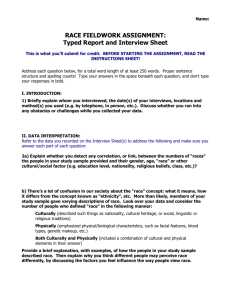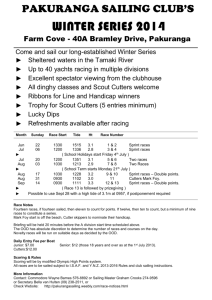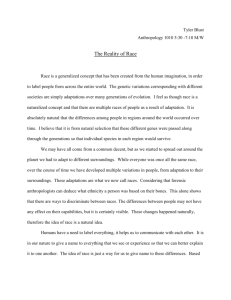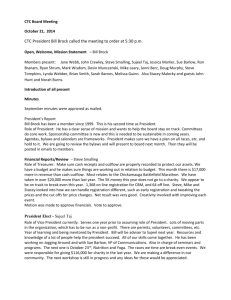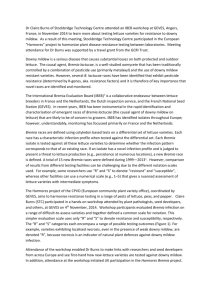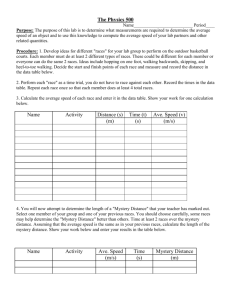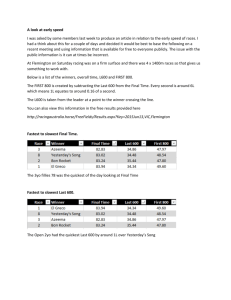Genetic analysis of the sunflower downy mildew resistance
advertisement
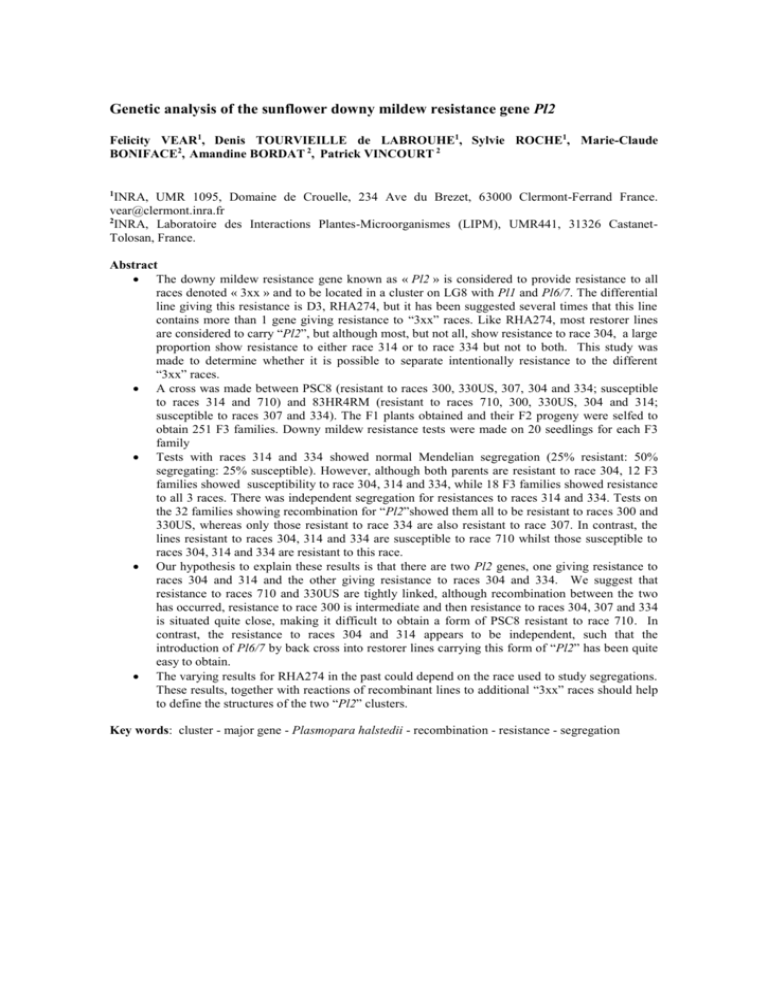
Genetic analysis of the sunflower downy mildew resistance gene Pl2 Felicity VEAR1, Denis TOURVIEILLE de LABROUHE1, Sylvie ROCHE1, Marie-Claude BONIFACE2, Amandine BORDAT 2, Patrick VINCOURT 2 1 INRA, UMR 1095, Domaine de Crouelle, 234 Ave du Brezet, 63000 Clermont-Ferrand France. vear@clermont.inra.fr 2 INRA, Laboratoire des Interactions Plantes-Microorganismes (LIPM), UMR441, 31326 CastanetTolosan, France. Abstract The downy mildew resistance gene known as « Pl2 » is considered to provide resistance to all races denoted « 3xx » and to be located in a cluster on LG8 with Pl1 and Pl6/7. The differential line giving this resistance is D3, RHA274, but it has been suggested several times that this line contains more than 1 gene giving resistance to “3xx” races. Like RHA274, most restorer lines are considered to carry “Pl2”, but although most, but not all, show resistance to race 304, a large proportion show resistance to either race 314 or to race 334 but not to both. This study was made to determine whether it is possible to separate intentionally resistance to the different “3xx” races. A cross was made between PSC8 (resistant to races 300, 330US, 307, 304 and 334; susceptible to races 314 and 710) and 83HR4RM (resistant to races 710, 300, 330US, 304 and 314; susceptible to races 307 and 334). The F1 plants obtained and their F2 progeny were selfed to obtain 251 F3 families. Downy mildew resistance tests were made on 20 seedlings for each F3 family Tests with races 314 and 334 showed normal Mendelian segregation (25% resistant: 50% segregating: 25% susceptible). However, although both parents are resistant to race 304, 12 F3 families showed susceptibility to race 304, 314 and 334, while 18 F3 families showed resistance to all 3 races. There was independent segregation for resistances to races 314 and 334. Tests on the 32 families showing recombination for “Pl2”showed them all to be resistant to races 300 and 330US, whereas only those resistant to race 334 are also resistant to race 307. In contrast, the lines resistant to races 304, 314 and 334 are susceptible to race 710 whilst those susceptible to races 304, 314 and 334 are resistant to this race. Our hypothesis to explain these results is that there are two Pl2 genes, one giving resistance to races 304 and 314 and the other giving resistance to races 304 and 334. We suggest that resistance to races 710 and 330US are tightly linked, although recombination between the two has occurred, resistance to race 300 is intermediate and then resistance to races 304, 307 and 334 is situated quite close, making it difficult to obtain a form of PSC8 resistant to race 710. In contrast, the resistance to races 304 and 314 appears to be independent, such that the introduction of Pl6/7 by back cross into restorer lines carrying this form of “Pl2” has been quite easy to obtain. The varying results for RHA274 in the past could depend on the race used to study segregations. These results, together with reactions of recombinant lines to additional “3xx” races should help to define the structures of the two “Pl2” clusters. Key words: cluster - major gene - Plasmopara halstedii - recombination - resistance - segregation INTRODUCTION Downy mildew resistance is an essential character for sunflower varieties grown in most countries, in particular in the USA, where Plasmopara halstedii originated, and in Europe, where frequent spring rainfall provides favourable conditions for the disease. Nearly 20 races are now known (Gulya, 2007), identified by the reaction of differential inbred lines (Tourvieille de Labrouhe et al, 2000). In the USA, “xx0” races, for example 330, 710, 730, 770 appear to be the most common, whereas, in France, although the predominant races are 703 (in the south) and 710 (further north), all the new races since 2000 have been “xx4” or “xx7”, for which Pl6/Pl7 do not provide resistance. Most restorer lines are considered to carry “Pl2”, a resistance gene giving resistance to “3xx” races, probably originating from wild H.annuus, through the USDA lines HA61 and RHA274 (Zimmer and Kinman, 1972). Using tests with race 100, the only race to which Pl2 gave resistance in France at that time, this gene was mapped in a cross between a susceptible and PAC2, an INRA restorer line, by BretMestries (1996). It was shown to be linked to the same RFLP markers as Pl1 (Mouzeyar et al, 1995) and Pl6 (Roeckel-Drevet et al, 1996) on LG8 (Cartisol LG 1) (Vear et al, 1997). However, with the appearance of new races, in particular 304, 314 and 334, restorer lines considered to carry Pl2 have shown differences in reaction. Although RHA274, Differential Line 3, gives resistance to all these races, many restorers are not resistant to race 334 and a small number are susceptible to race 314. Vear et al (1997) reported that recombination could occur within the Pl6 locus, resulting in lines that are resistant to races 710 and 703 but susceptible to races 300 and 100 and so it appeared likely that the different reactions of lines carrying Pl2 could be due to losses of certain parts of this resistance gene / cluster. To determine whether it is possible to obtain recombination within the Pl2 locus intentionally, studies were made of progenies obtained from a cross between 2 inbred lines with different resistance profiles to “3xx” races. MATERIALS AND METHODS Sunflower genotypes: The progenies studied came from a cross between two INRA lines. PSC8 was bred from a recurrent selection population for Sclerotinia resistance, and was one of the parents of the Inedi (XRQ x PSC8) RIL, used for mapping Pl5 (Bert et al, 2001) and many other characters. 83HR4RM was developed from a cross between Russian population VNIIMK 6540 and RHA274 and then converted to race 710 resistance by introduction of Pl7 by back crossing. Among the races tested in the present study, PSC8 is resistant to 300, 330(US), 304, 334 and 307 and susceptible to 314 and 710 whereas 83HR4RM is resistant to 300, 330(US), 304, 314 and 710 and susceptible to 307 and 334. Seven F1 plants were selfed to obtain 251 F2 plants which were in turn selfed to give F3 progenies. According to the amount of seed available and the interest of the progeny, these were further selfed to obtain F4 and F5 generations. When necessary, 2 or 3 F4 progenies were tested to determine or to check the status of their F3 parent. Downy mildew races: The races used were 304, 314, 334, 307, 330(US), 300 and 710, all maintained at INRA, Clermont Ferrand at -80°C and multiplied when necessary after verification with differential lines. Race 330(US) differs from a Spanish sample of this race because XRQ (the second parent of the Inedi RIL) and VAQ (a new differential proposed by Tourvieille de Labrouhe et al, 2012) are susceptible, whereas they are resistant to 330(SP). Downy mildew resistance tests: These were made in NS2 or NS3 confined growth chambers, according to whether the race exists in France or is introduced, and for French races, the number of progenies to be tested. Methods were those of Mouzeyar et al (1993). For each F3 progeny, 20 infected seeds were pricked out. Observations were made 2 weeks later, after 48h at 100%RH. Progenies were defined as homozygous resistant (RR), segregating (seg) and homozygous susceptible (SS). Some cotyledon - limited sporulation was observed, especially with race 314, and, in this case, the overall behaviour of the progeny was considered to define the result, but a few progenies remained with a question mark. RESULTS Table 1 presents the reactions (homozygous resistant, segregating and homozygous susceptible) of F3 families to races 304, 334 and 314 considered separately. Races 334 and 314 show 1 RR : 2 seg : 1 SS typical for F3 segregation for a single dominant gene. There was a slight, non-significant excess of resistant and segregating families for race 314, which is not very aggressive. Some plants had profuse sporulation on cotyledons but no sporulation on true leaves, and could be “Type 2” resistant or susceptible. A few progenies may have been considered as “RR” or “seg” when they were genetically “seg” or “SS”. For race 304, since both parents of the cross are resistant, it had been expected that there would be no or only rare progenies showing susceptibility. In fact, the segregation, with 11 SS families out of 251, is Table 1. Segregation of F3 families from the cross PSC8 x 83HR4RM tested with downy mildew races 334, 314 and 304 ( RR: homozygous resistant, seg: segregating, SS: homozygous susceptible). Race RR seg SS 334 56 133 60 314 304 observed 304 cf 314+334 70 115 50 140 99 12 102 137 12 To tal 24 9 23 5 25 1 25 1 segregation 1RR : 2seg : 1SS 1RR : 2seg : 1SS 7RR : 8seg : 1SS 7RR : 8seg : 1SS X² 1.29 ns (2df) 3.51 ns (2df) 15.28**(2df ) 2.48 ns (2df) not significantly different from the theoretical result for 2 independent dominant genes (7 RR:8 seg:1 SS). The observations gave results with an excess of apparently homozygous resistant families and a lack of those showing segregation, but this was almost certainly due to segregation for two genes giving resistance to race 304, such that only 1\16th of a progeny would be susceptible in half of the segregating progenies and this was not always visible among the 20 seedlings observed. If the families counted as RR for 304 but which were segregating or susceptible to races 314 and 334 are considered as segregating, the numbers agree with the theoretical segregation 7RR:8seg:1SS (Table 1). This interpretation was confirmed by the 23 F3 progenies which showed only one susceptible plant, whereas others presented up to nine among the 20 seedlings observed. When segregation for races 314 and 334 were considered together, 20 families were found to be resistant to both races and 15 to be susceptible to both, and were thus recombinants compared with the parents. The total segregations, presented in Table 2, are not significantly different from the theoretical for 2 independent genes each giving resistance to 1 race. Table 2. Segregation for resistance to downy mildew races 314 and 334 in (PSC8 x 83HR4RM)F3 progenies. 2a. Theoretical segregations for F3 progeny according to the hypothesis for two independent dominant genes. A/a: resistance/susceptibility to race 334 B/b: resistance/susceptibility to race 314 R: homozygous resistant; seg: segregating; S: homozygous susceptible AB Ab aB ab AB RR Rseg segR segseg Ab Rseg RS segseg segS aB segR segseg SR Sseg Ab segseg segS Sseg SS 2b. Expected and observed numbers of progenies of each category 2=1/8 4=1/4 expected observed expected observed expected observed 4 segseg 58.24 60 1 RR 14.56 18 2 Rseg 29.12 25 1 SS 14.56 14 2 segR 29.12 33 1 RS 14.56 10 2 segS 29.12 30 1 SR 14.56 15 2 Sseg 29.12 26 X² = 3.23 ns (8df) Table 3. Reaction of parents and homozygous recombinant (83HR4RM x PSC8)F3 progenies when tested with seven downy mildew races. 1=1/16 Inbred line / Race 304 334 83HR4RM R S PSC8 R R Recombinant, homozygous F3 progenies 17 progenies R R 12 progenies S S 1 progeny R S 1 progeny R S 1 progeny R R 314 R S 300 R R 330 R R 307 S R 710 R S R S S S R R R R R R R R R R R R S R S R S R R R R There was no evidence for any recombination within the 2 Pl2 loci. There were no progenies resistant or segregating to races 314 or 334 and susceptible to race 304. When the 35 recombinant progenies were tested with additional races (Table 3), all those susceptible to races 304, 314 and 334 were found to be resistant to race 710 whereas all the RR lines except one (which needs to be checked) were susceptible to this race. Reactions of these 35 lines to race 307 were exactly the same as for race 334, (again with one exception which will be checked). In contrast, all these progenies, both the RR and the SS, were resistant to races 330(US) and 300. DISCUSSION Experience has shown that, although controlled by major genes, sunflower seedling reactions to downy mildew is not just a question of “one visible spore = susceptibility” as we considered at first. It is now well known that “Type 2” (or “RII”) resistance exists (Radwan et al, 2002), with sporulation on cotyledons, However, it is also possible, with weakly aggressive downy mildew races such as 314, that such symptoms occur for “genetically susceptible” plants. “Type 2” resistance is most usual for Pl1, Pl5 and Pl8, it is not common for Pl2, but, in this study, some plants were difficult to place in resistant or susceptible categories. This problem of observation is certainly one of the explanations for differences between results published in the past, especially concerning apparently new genes, Studies on F3 progenies rather than F2 plants take longer and require more tests but they make possible conclusions in spite of some indeterminate plants, with the possibility of checks on additional samples or further generations. In addition, they make possible tests with a wide range of races. Seven races have been used in this study and it is planned to check the reaction of the recombinant progenies to race 100 and other “3xx” races. The results presented here suggest that there are 2 “Pl2” genes, one giving resistance to races 304 and 314 and the other giving resistance to races 304, 307 and 334. One of the genes, for the moment denoted as “Pl2a”, from PSC8, is the Pl2 located in the large cluster on LG8, with Pl1 and Pl6/7. The other gene,”Pl2b”, in 83HR4RM giving resistance to races 304 and 314, is situated such that it segregates independently from “Pl2a” and from Pl6/7. This would explain why it has never been possible to obtain a form of PSC8 resistant both to race710 and race 304, whereas, for 83HR4 there was no difficulty. This gene is probably the most common in modern restorer lines, and certainly present in all those that have been converted to 710/703 resistance by back cross introduction of Pl6/Pl7. The results of tests of the recombinant F3 and F4 families with race 330(US) and 300 (Table 3) are more difficult to interpret since resistance to these races did not follow that of 304. Both parents were resistant to all three races, but whereas some F3 families were susceptible to race 304, all those tested were resistant to both 300 and 330(US). This leads to the conclusion that, in contrast to race 304 resistance, PSC8 and 83HR4RM have the same gene or genes giving resistance to races 300 and 330(US). Tourvieille de Labrouhe et al (2012) showed that Y7Q and YVQ, lines bred from crosses between completely susceptible lines and HA335 and HA338 respectively and containing recombinant forms of Pl6 or Pl7 only, were resistant to races 330(US), 703, 710, and 730 but susceptible to races 100 and all the other “3xx” races including 300. This suggests that resistance to races 330(US) is more tightly linked to 710 and 703 resistance than that to race 304 given by “Pl2a” and that resistance to race 300 is in intermediate position. Tourvieille de Labrouhe et al (2012) also showed that many “RM” forms of restorer lines, including 83HR4RM, have lost the resistance to races 307 and 334 if it was present in the original forms. Thus, we propose the hypothesis that on LG8, the order of sequences giving resistance is 710/703, then 330(US), then 300 and then 304/307/334. However, in the original wild Helianthus annuus which provided both Pl2 and Pl6, there must have been some variability and recombination in this area to give Pl2 and Pl6 separately. The first reports of Pl2 were by Zimmer and Kinman (1972) and Fick and Zimmer (1974), who indicated that both HA61 and RHA274 carried a single dominant gene Pl2 giving resistance to race 300 (called race 2 at that time). Based on the gene for gene hypothesis, Gulya et al (1991), suggested that RHA274 carried not only Pl2, giving resistance to race 300 but also Pl9, giving resistance to race “6” (probably 310). However, they did not study genetic segregation patterns for the 2 genes. Molinero-Ruiz et al (2003) observed segregations indicating a single gene for resistance to race 310 in RHA274 and RHA325, which they confirmed as Pl9, but made no comparison with Pl2. These authors also reported (Molinero-Ruiz et al, 2002) that both RHA274 and HA61 carried 2 complementary genes for resistance (Plw and Plx) to race 330(SP) giving F2 segregations of 13R : 3S, meaning that the double recessive was resistant. Rahim et al (2002) reported segregations indicating 2 independent genes in RHA274 giving resistance to races 100 and 300 and since they considered that for each race, different genes are involved, they concluded that RHA274 carries Pl1 and Pl11 giving resistance to race 100 and Pl2 and Pl12 giving resistance to race 300. For the main tests reported here, the races were not the same as those used by all these authors so it is rather difficult to combine conclusions. Nevertheless, it appears likely that the varying results for RHA274 in the past could depend on the “3xx” race used to study segregations, there being only 1 gene active against some races and 2 against others. Whether “Pl2b” is an imperfect duplication of “Pl2a” or quite different, remains to be determined, but it leads to the question of gene denomination. It can be suggested that as “Pl2b” is independent of “Pl2a”, the original Pl2, and gives resistance to some different downy mildew races, it should have a new name, we suggest Pl21, to show its similarity with Pl2, rather than Pl9 or Pl11 or Pl12. For a definitive answer, all the “genes” so far named need to be reconsidered. In the same way as logical triplet names for downy mildew races have been used since their proposition by Gulya et al, 1998, it would be very useful to have resistance gene numbers that indicate similarities and differences. It could be the occasion for a collaborative international initiative to map the genes in all the known resistance sources to prepare the most satisfactory denomination. In conclusion, at present, we suggest that Pl2 is situated close to Pl6/7 but that resistance to races 304, 307 and 334 are more loosely linked to resistance to the locus giving resistance to races 703 and 710 than that giving resistance to race 330(US), with resistance to race 300 in an intermediate position, while Pl21 is independent. The results of mapping of this last gene will soon be available and then it will be interesting to make detailed sequence studies to determine the differences between the two loci, which could help to clarify the relationship between DNA sequences and race specific downy mildew resistances. ACKNOWLEDGEMENTS We would like to thank Promosol for financial support of this programme. REFERENCES Bert P-F., D. Tourvieille de Labrouhe, J. Philippon J, S. Mouzeyar, I. Jouan, P.Nicolas, and F.Vear. 2001. Identification of a second linkage group carrying genes controlling resistance to downy mildew (Plasmopara halstedii) in sunflower (Helianthus annuus L.). Theor.Appl.Genet. 103 :992997. Bret-Mestries E. 1996. Recherche de QTL (Quantitative Trait Loci) impliquées dans la résistance du tournesol (Helianthus annuus L.) à la pourriture blanche, causée par Sclerotinia sclerotiorum (Lib.) de Bary. Doctoral Thesis, Univ. Clermont-Ferrand II, INRA Clermont-Ferrand, France, 152 p. Fick, G.N., and D.E. Zimmer. 1974. RHA271, RHA273, RHA274 Sunflower parental lines for producing downy mildew resistant hybrids. Farm Research 32:7-9. Gulya, T.J. 2007. Distribution of Plasmopara halstedii races from sunflower around the world. p. 135142. In: “Advances in Downy Mildew Research” Vol. 3 Proc. of the 2nd International, Downy Mildew Symposium. 2–6 July 2007, Palcky, University in Olomouc and JOLA, v.o.s., Kostelec na Hane, Czech Republic. Gulya, T.J., W.E. Sackston, F. Viranyi, S. Masirevic, and K.Y. Rashid. 1991. New races of the Sunflower Downy Mildew Pathogen (Plasmopara halstedii) in Europe and North and South America. Journal of Phytopathology, 132: 303-311. Gulya, T.J., D. Tourvieille de Labrouhe, S. Maširevic, A. Penaud, K. Rashid, and F. Viranyi. 1998. Proposal for standardized nomenclature and identification of races of Plasmopara halstedii (sunflower downy mildew). In: Proc. ISA Symposium III, Sunflower Downy Mildew, Fargo, ND, USA, 13-14 Jan. 1998, 130-136. Molinero-Ruiz, M.L., J.M. Molinero-Vera and J.Dominguez. 2002. Inheritance of resistance to race 330 of Plasmopara halstedii in three sunflower lines. Plant Breeding 121:61-65. Molinero-Ruiz, M.L., J.M. Molinero-Vera and J.Dominguez. 2003. Inheritacne of resistance to two races of sunflower downy mildew (Plasmopara halstedii) in two Helianthus annuus L. lines. Euphytica 131:47-51. Mouzeyar S., D.Tourvieille de Labrouhe and F.Vear. 1993. Histopathological studies of résistance of sunflower (Helianthus annuus L.) to downy mildew (Plasmopara halstedii Farl. Berlese et de Toni). J. Phytopathology, 139: 289-297. Mouzeyar S., P.Drevet-Roeckel, J.Phillipon, L.Gentzbittel, F.Vear, D.Tourvieille de Labrouhe and P.Nicolas. 1995. RFLP and RAPD mapping of the sunflower Pl1 gene for résistance to Plasmopara halstedii race 1. Theor.Appl.Genet. 91: 733-737. Radwan O, M.F.Bouzidi, F.Vear, J.Phillipon, D.Tourvieille de Labrouhe, P.Nicolas and S.Mouzeyar. 2002. Identification of non-TIR-NBS-LRR markers linked to the Pl5/Pl8 locus for resistance to downy mildew in sunflower Theor.Appl.Genet. 106:1438-1446 Rahim M., C.C.Jan and T.J.Gulya. 2002. Inheritance of resistance to sunflower downy mildew races 1, 2 and 3 in cultivated sunflower. Plant Breeding 121:57-60. Roeckel-Drevet P., G.Gagne, S.Mouzeyar, L.Gentzbittel, J.Phillipon, P.Nicolas, D.Tourvieille de Labrouhe and F.Vear. 1996. Colocation of downy mildew (Plasmopara halstedii) résistance genes in sunflower (Helianthus annuus L.) Euphytica, 91, 225-228. Tourvieille de Labrouhe, D., T.J. Gulya, S. Maširevic, A. Penaud, K. Rashid, and F. Viranyi. 2000. New nomenclature of races of Plasmopara halstedii (sunflower downy mildew). Proc. 15 th Int. Sunfl. Conf., Toulouse, France, 12-15 June, pp. I 61-I 66. Tourvieille de Labrouhe D., P.Walser, D.Joliovot, S.Roche, F.Serre, F.Delmotte, A.Bordat, L.Godiard, P.Vincourt, F.Vear. 2012. Proposal for improvement of sunflower downy mildew race nomenclature. In Proc. 18th Int. Sunfl. Conf. Mar del Plata, Argentina, Int. Sunfl. Assoc.Paris, France (in press). Vear F., Gentzbittel L., Philippon J., Mouzeyar S., Mestries E., Roeckel-Drevet P., Tourvieille De Labrouhe D. & Nicolas P. 1997. The genetics of resistance to five races of downy mildew (Plasmopara halstedii) in sunflower (Helianthus annuus L.). Theor.Appl.Genet., 95, 584-589. Zimmer D.E. and M.L.Kinman. 1972. Downy mildew resistance in cultivated sunflower and its inheritance. Crop Science 12: 749-751.
